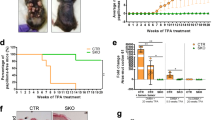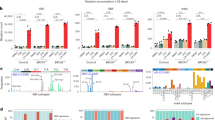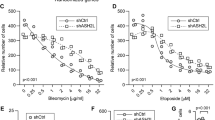Abstract
While it is well known that MNU induces thymic lymphomas in the mouse, it remains unclear which pre-mutagenic lesions are responsible for lymphomagenic transformation. One lesion thought to play a critical role is O6methylguanine [O6mG] which initiates G : C to A : T transition mutations in K-ras and other oncogenes. O6alkylguanine-DNA alkyltransferase (AGT), encoded by the methylguanine methyltransferase gene [MGMT], removes the methyl group thereby preventing the mutation from occurring. When overexpressed in the thymus, MGMT protects mice from MNU-induced thymic lymphomas. To determine whether MGMT overexpression reduced G : C to A : T mutation frequency after MNU, Big BlueTM lacI and MGMT+/Big BlueTM mice were treated with MNU and analysed for mutations in the lacI and K-ras genes. The incidence of MNU-induced lymphomas was 84% in Big BlueTM lacI mice compared to 14% in MGMT+Big BlueTM lacI mice. Sixty-two per cent of the lymphomas had a GGT to GAT activating mutation in codon 12 of K-ras consistent with O6mG adduct-mediated point mutagenesis. LacI mutation frequency in thymus of MNU treated Big BlueTM mice was 45-fold above background whereas it was 11-fold above background in MNU treated MGMT+/Big BlueTM mice. Most lacI mutations were G : C to A : T transitions, implicating O6mG even in the MGMT+ mice. No mutations were attributable to chromosomal aberrations or rearrangements. Thus, O6mG adducts account for the carcinogenic effect of MNU and MGMT overexpression is selectively able to reduce O6methylguanine adducts below a carcinogenic threshold. Other adducts are mutagenic but appear to contribute much less to malignant transformation or oncogene activation.
This is a preview of subscription content, access via your institution
Access options
Subscribe to this journal
Receive 50 print issues and online access
$259.00 per year
only $5.18 per issue
Buy this article
- Purchase on Springer Link
- Instant access to full article PDF
Prices may be subject to local taxes which are calculated during checkout


Similar content being viewed by others
Abbreviations
- AGT:
-
O6-alkylguanine DNA-alkyltransferase protein
- MGMT:
-
methylguanine DNA-methyltransferase gene
- MMR:
-
mismatch repair
- MNU:
-
N-methyl-N-nitrosourea
- PFU:
-
plaque forming unit
References
Ali RB, Teo AK, Oh HK, Chuang LS and Ayi TC and Li BF. . 1998 Mol. Cell. Biol. 18: 1660–1669.
Becker K, Dosch J, Gregel CM, Martin BA and Kaina B. . 1996 Cancer Res. 56: 3244–3249.
Cha RS, Thilly WG and Zarbl H. . 1994 Proc. Natl Acad. Sci. USA 91: 3749–3753.
Corominas MPM, Newcomb EW and Pellicer A. . 1991 Cancer Res. 51: 5129–5133.
de Boer JG, Provost S, Gorelick N, Tindall K and Glickman BW. . 1998 Mutagenesis 13: 109–114.
Dobo KL, Eastmond DA and Grosovsky AJ. . 1998 Carcinogenesis 19: 755–764.
Domoradzki J, Pegg AE, Dolan ME, Maher VM and McCormick JJ. . 1985 Carcinogenesis 6: 1823–1826.
Dosanjh MK, Singer B and Essigmann JM. . 1991 Biochemistry 30: 7027–7033.
Dosanjh MK, Menichini P, Eritja R and Singer B. . 1993 Carcinogenesis 14: 1915–1919.
Dumenco LL, Allay E, Norton K and Gerson SL. . 1993 Science 259: 219–222.
Galloway SM, Greenwood SK, Hill RB, Bradt CI and Bean CL. . 1995 Mutat. Res. 346: 231–245.
Gerson SL, Miller K and Berger NA. . 1985 J. Clin. Invest. 76: 2106–2114.
Kohler SW, Provost GS, Fieck A, Kretz PL and Bullock WO, Sorge JA, Putman DL and Short JM. . 1991 Proc. Natl Acad. Sci. USA 88: 7958–7962.
Liu L, Allay E, Dumenco L and Gerson SL. . 1994 Cancer Res. 54: 4648–4652.
Lukash LL, Boldt J, Pegg AE, Dolan ME and Maher VM and McCormick JJ. . 1991 Mutat. Res. 250: 397–409.
Moriwaki S, Yagi T, Nishigori C, Imamura S and Takebe H. . 1991 Cancer Res. 51: 6219–6223.
Nakatsuru Y, Matsukuma S, Nemoto N, Sugano H and Sekiguchi M and Ishikawa T. . 1993 Proc. Natl Acad. Sci. USA 90: 6468–6472.
Nivard MJ, Pastink A and Vogel EW. . 1996 Mutat. Res. 352: 97–115.
Sassanfar M, Dosanjh MK, Essigmann JM and Samson L. . 1991 J. Biol. Chem. 266: 2767–2771.
Sitaram A, Plitas G, Wang W and Scicchitano DA. . 1997 Mol. Cell. Biol. 17: 564–570.
Strauss BS. . 1991 Bioessays 13: 79–84.
Trey JE and Gerson SL. . 1989 Cancer Res. 49: 1899–1903.
Zaidi N, Allay E, Ayi T, Li B, Dumenco L, Sy M and Gerson SL. . 1995a Carcinogenesis 16: 1047–1053.
Zaidi N, Pretlow T, O'Riordan M, Dumenco L and Allay E and Gerson SL. . 1995b Carcinogenesis 16: 451–456.
Zarbl H, Sukumar S, Arthur AV, Martin-Zanca D and Barbacid M. . 1985 Nature 315: 382–385.
Acknowledgements
We thank Dr Lili Liu for performing the AGT assays and Drs Jay Short and Jim Allay for helpful discussions in the course of this study. This work was supported in part by USPHS Grants P30CA43703, RO1CA63193, RO1ES06288, RO1CA73062.
Author information
Authors and Affiliations
Rights and permissions
About this article
Cite this article
Allay, E., Veigl, M. & Gerson, S. Mice over-expressing human O6alkylguanine-DNA alkyltransferase selectively reduce O6methylguanine mediated carcinogenic mutations to threshold levels after N-methyl-N-nitrosourea. Oncogene 18, 3783–3787 (1999). https://doi.org/10.1038/sj.onc.1202697
Received:
Revised:
Accepted:
Published:
Issue Date:
DOI: https://doi.org/10.1038/sj.onc.1202697
Keywords
This article is cited by
-
Balancing repair and tolerance of DNA damage caused by alkylating agents
Nature Reviews Cancer (2012)
-
Mutational-reporter transgenes rescued from mice lacking either Mgmt, or both Mgmt and Msh6 suggest that O6-alkylguanine-induced miscoding does not contribute to the spontaneous mutational spectrum
Oncogene (2004)
-
MGMT: its role in cancer aetiology and cancer therapeutics
Nature Reviews Cancer (2004)
-
Effect of the altered codon position and encoded amino acid on transformation by point mutation in ras genes
Revista de Oncología (2002)
-
Overexpression of human O6-alkylguanine DNA alkyltransferase (AGT) prevents MNU induced lymphomas in heterozygous p53 deficient mice
Oncogene (2001)



